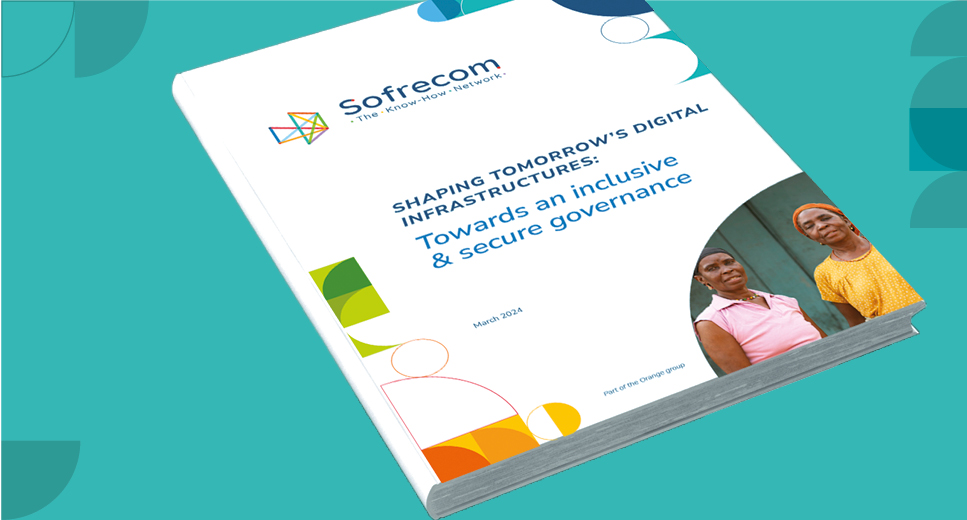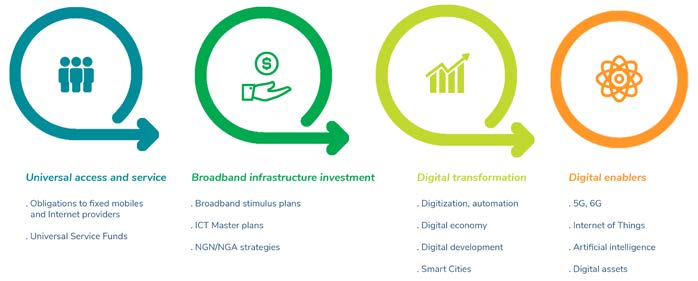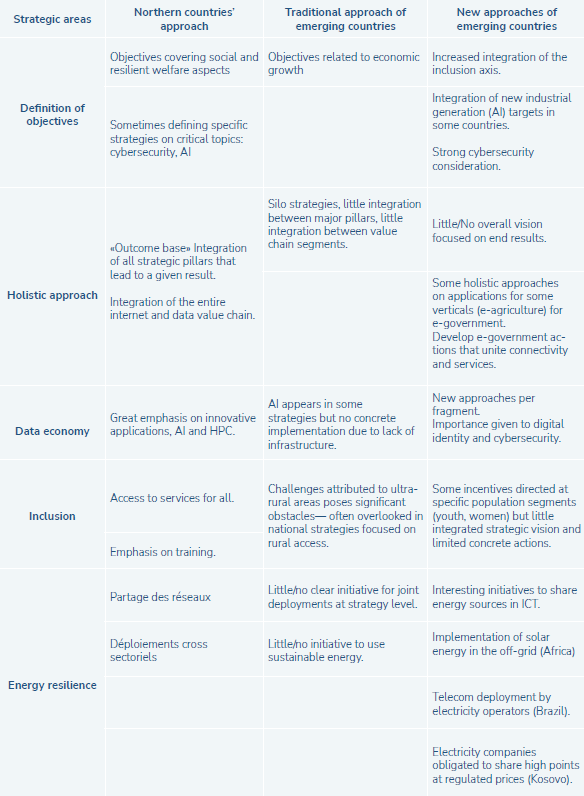
The implementation of national or regional (Europe, CEDEA0, Mercosur) digital strategies represents a pivotal aspect of technological and industrial policy. It serves to provide a framework for state actions while fostering technological cohesion within a region. Awareness of climate and societal issues, alongside the uneven development of technological solutions influenced by the Millennium Goals1, has underscored a clear evolution in the approach to digital strategies. These strategies now recognize technology as a fundamental component for improving quality of life, rather than simply as a technological objective unto itself.
Settin objectives : transitioning from GDP growth to population well-being
The formulation of objectives for digital strategies has evolved significantly, shifting from a singular focus on GDP growth to encompass the broader spectrum of economic, social, and environmental well-being for populations. This profound transformation has fundamentally reshaped the methodology behind formulating strategies.
While the impact of digital initiatives on GDP remains noteworthy, it is increasingly acknowledged as inadequate due to its failure to address the equitable distribution of growth across society. This realization has prompted a paradigm shift away from the traditional emphasis solely on GDP growth towards a more comprehensive approach that prioritizes objectives aimed at enhancing social equity, fostering economic prosperity, and ensuring environmental sustainability.
For example, the International Telecommunication Union (ITU)2, previously focused on advancing growth metrics, has pivoted towards promoting universal accessibility and facilitating sustainable digital transformation. Similarly, the European Union3 has repositioned the single market as a strategic platform for promoting integration and driving industrial progress, particularly in pivotal areas such as artificial intelligence (AI), supercomputing, and digital literacy, all while underscoring the critical importance of energy resilience.
Consequently, connectivity is now viewed not merely as a means to an end but as a means to attain societal excellence and optimize energy consumption. High-speed broadband infrastructure, for instance, serves as a catalyst for generating cutting-edge content with minimal latency, including applications in artificial intelligence, high-performance cloud computing, and advanced HPC4 applications.
The holistic approach
The holistic approach is characterized by the definition of strategic components focused on the desired final outcome. Avoiding a siloed approach to digital development leads to coordinated actions that integrate the end-to-end value chain of the internet. Few countries in the North still have comprehensive broadband plans, as it is considered that minimal coverage has been achieved. Today, the focus is on implementing digital excellence plans while carrying out cross-sectoral actions to deploy unique passive networks carrying both energy and information and communication technology (ICT) networks. On the other hand, the cross-sectoral approach to network deployment has been recommended for a decade with initiatives such as ‘Dig Once’ supported by the World Bank. However, its concrete implementation has only occurred in countries subject to strong regulatory pressure, primarily in Northern countries.
Articulation of strategic components

From economy data to data economy
While data on economy aimed to collect information transmitted through networks on individuals, institutions, or research, the emergence of the data economy signifies a profound paradigm shift, wherein data itself becomes a commodity.
The data-driven economy exhibits distinctive structural traits, positioning it as a pivotal entity within the broader framework of endogenous growth and potentially heralding an entirely novel economic model. These defining characteristics encompass pervasive information asymmetry, the integration of artificial intelligence (AI) for large-scale learning, and novel modes of commerce and exchange whose value defies traditional economic accounting systems. In this dynamic landscape, cybersecurity emerges as a critical pillar, alongside disruptive and innovative applications driving transformative change.
Consequently, whether in emerging countries or in the North, robust cybersecurity frameworks are imperative components of all forward-looking strategies.

Inclusion and energy resilience: The two new pillars of ICT development
In Northern countries, the concept of inclusion revolves around ensuring widespread access to services. However, in emerging countries, connectivity remains a crucial determinant of development. In the former, it entails the citizens’ equal access to e-government services, healthcare, and education. Conversely, in the latter, it involves extending coverage to isolated populations to facilitate basic communications.
Emerging countries encounter a two-fold challenge: deploying networks while maintaining energy efficiency, particularly in areas with unreliable or nonexistent electrical distribution. Consequently, governments and operators are actively pursuing innovative solutions. This includes initiatives like installing light towers powered by
solar energy.
Additionally, they are striving for greater deployment efficiency by promoting the shared use of passive infrastructures by both electrical and telecom operators. Notable examples of such collaborative efforts include projects in Kosovo, Burkina Faso, and Mozambique.
The imperative for emerging countries
Although it is strongly recommended for emerging countries to integrate the Millennium Goals into their digital strategies, especially due to the influence of stakeholders, the reality of the applicability of this approach is complex, particularly when it comes to inclusion. While actions in favor of integrating the youth and women are outlined in many strategies under the influence of international organizations, few concrete actions have been taken. However, new approaches, stemming from the ability to adapt solutions to local realities, are emerging and are sometimes (especially in the case of energy) more disruptive than the approaches adopted by Northern countries.
Emerging countries are striving to carve their own path towards achieving the Millennium Goals and demonstrate their strong abilities to adapt to these objectives and local realities. It is highly likely that the existing fragments’ initiatives will evolve into more coordinated and expansive strategies with the establishment of multiple single markets (UEMOA, MERCOSUR, etc.) and the proactive support of international organizations.







